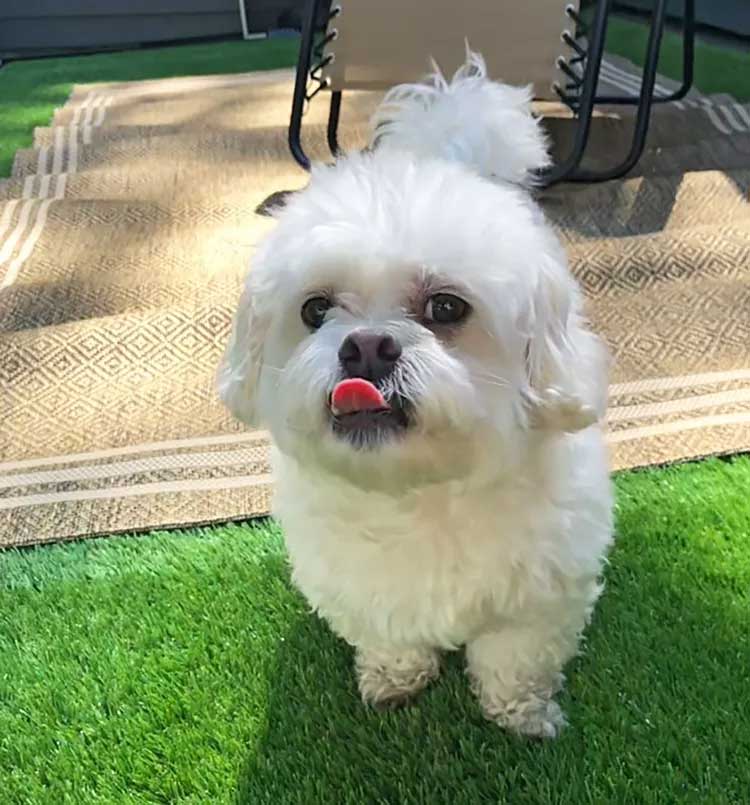The Peekapoo, a cross between a miniature or toy poodle and a Pekingese, is an adorable, affectionate lapdog. Although the “designer” dogs are small in size, the breed is known for his big bark.

Peekapoo Overview
| OFFICIAL NAME | Peekapoo |
| COMMON NAME | Peekapoo |
| PET HEIGHT | 6 to 11 inches |
| PET WEIGHT | 4 to 20 pounds |
| LIFESPAN | 10 to 15 years |
| GOOD WITH | dogs, families, seniors |
| TEMPERAMENT | friendly, gentle, playful |
| INTELLIGENCE | high |
| SHEDDING AMOUNT | infrequent |
| EXERCISE NEEDS | low |
| ENERGY LEVEL | calm |
| VOCAL LEVEL | frequent |
| DROOL AMOUNT | low |
| BREED GROUP | hybrid |
| BREED SIZE | small (0-25 lbs.) |
| COAT LENGTH | curly, medium, short |
| COLORS | black, brown / chocolate / liver, cream, gold / yellow, gray, white |
| PATTERNS | bicolor |
| OTHER TRAITS | apartment-friendly, easy to train, hypoallergenic, strong loyalty tendencies |
The Peekapoo is considered one of the original "designer" or hybrid dog breeds. The first Pekingese-poodle mixes were bred in the 1950s to meet the demand for small dogs with low-shedding, "hypoallergenic" coats, and the breed remains popular today.
Similar to their parent breeds, adult Peekapoos are small in stature, standing less than 11 inches tall and weighing between 4–20 pounds. A Pekingese crossed with a toy poodle is smallest and called a teacup Peekapoo. But what these dogs lack in size, they make up for in personality.
"Pekingese are independent and stoic, and poodles like to be the life of the party; Pekingese are more aloof and poodles can be quite clingy," says Jennifer Hart, founder of Hart-2-Heart Rescue in Greensboro, North Carolina. "Combining a Pekingese and a poodle can make for a fairly balanced dog that is affectionate but independent, too."
Pekingese were bred to guard palaces and emperors in Asia, which means the Peekapoo isn't afraid to sound the alarm to warn that strangers are near. The old adage, "their bark is bigger than their bite," holds true with the breed; they're very vocal and believe it's their job to act as their owners' personal alarm system, Hart says.
At home, the Peekapoo is loving and loyal. He's a low-energy breed that embodies the definition of lapdog and, thanks to his poodle roots, thrives on constant companionship. He'll make the perfect furry friend for senior citizens.
Appearance
Because the Peekapoo is not a purebred dog, there is no formal breed standard guiding how the pups should look. In fact, their appearances can be quite varied and include a combination of traits taken from their toy or miniature poodle and Pekingese parents.
The miniature poodle and the Pekingese are small dog breeds, and the Peekapoo is, too. The dogs can reach up to 11 inches tall and weigh between 4–20 pounds, depending on whether their poodle parent was a toy or miniature breed. These petite pups have coats in colors ranging from silver, grey, chocolate and black to white, cream, apricot, and buff.
The breed, which was developed for owners with allergies, tends to have a low-shedding coat that's considered hypoallergenic. And while there's no such thing as a truly hypoallergenic pet, the Peekapoo might be a good option for someone who gets itchy eyes or a stuffy nose around dogs.
But low-allergen doesn't equal low-maintenance; some Peekapoos have longer coats that require daily brushing, while others have short or clipped coats that can be brushed weekly.
Temperament
Both poodles and Pekingese are intelligent, affectionate, and loyal; traits that are reinforced in Peekapoos. These are dogs that love spending time with their people and will happily tag along for (rather short) walks or errands, but are happiest curled up in your lap."Social isolation can be very challenging for any poodle mix," Hart says.
But the Peekapoo's "love me, love me" personality may not extend to strangers. Hart notes this hybrid can be aloof with strangers—in fact, the breed make excellent watch dogs, as they tend to bark when strangers approach.

The Peekapoo tends to be a low-energy breed that would rather nap on the sofa than chase a ball. Though most will get along well with other laid-back pets that match their energy levels (or lack of), Hart notes the breed might not be the best choice for homes with small children. Due to their small size and tendency to get underfoot, their little bodies could be accidentally injured by kiddos. Always supervise kids when they play with any pup, and teach them how to interact with animals.
Consistent positive reinforcement training is important to help Peekapoos learn basic commands. Because the parent breeds are both hailed for their intelligence, training will also help provide your Peekapoo much-needed mental stimulation. And he'll love getting treats as a reward!
Living Needs
The Peekapoo is a lapdog at heart. The breed has minimal exercise needs; a quick walk around the block is usually enough to tire out these petite pooches. Afterward, he'd prefer to be curled up on the couch with his owner. In fact, the Peekapoo's desire for companionship is one of his most charming—but challenging—traits.
Peekapoos will do best in a home where their owners are around most of the time. Like other small dogs, Peekapoos don't require a ton of space. Apartment living is fine, but they do have a tendency to bark, which could annoy the neighbors.
While Peekapoos get along well with other animals, including cats and other dogs, these pups prefer to be the center of attention. Due to their small size, the breed is best suited to homes with older children. If in doubt, Hart suggests asking Peekapoo rescue groups about the dog's behavior in his foster home.
"If you choose the rescue route [to adopt a Peekapoo], the foster will know how the dog is with children, cats, and other dogs," she explains.
If you're bringing home a puppy from a Peekapoo breeder, early socialization will help him learn to live with other animals—and not be so suspicious and bark-y around new people.
Care
A Peekapoo's low-shedding, hypoallergenic coat requires regular brushing. Dogs with longer coats may need to be brushed every day, while weekly brushing is sufficient for dogs with short coats—or for Peekapoos with short, stylish haircuts. If you want to his coat clipped, plan to schedule an appointment with a professional groomer every six to eight weeks.Like other breeds, Peekapoos also need regular nail trims, and routine dental care will help keep their pearly whites healthy.
When it comes to exercise, a Peekapoo is much more low-maintenance. A quick walk around the block might be enough to satisfy his exercise needs, but be sure to allow him time to sniff out their surroundings.
"Exercise is as much about social enrichment as exercise," Hart says. "It's good for Peekapoos to have the mental stimulation that comes from exploring their surroundings."

In hot weather, the short-nosed breed is at high risk of overheating. Hart says it's a good idea to provide puzzle feeders, interactive toys, training games, and other opportunities for Peekapoos to keep their brains busy when the sun is shining a bit too hard for outside exercise.
Health
The Peekapoo has an average lifespan of 10 to 15 years. Both parent breeds share similar health issues that might be passed along to the Peekapoo, including:Brachycephalic Obstructive Airway Syndrome: BOAS is common in brachycephalic (aka flat-faced) dogs including the Pekingese. Their short muzzles and noses result in small or flattened breathing passages that make it harder for them to breathe, even when resting. Dogs with BOAS can't do much exercise and are at an increased risk of overheating, especially in hot weather. Obesity makes BOAS worse so it's important to help your Peekapoo maintain a healthy weight. Your veterinarian may also recommend anti-inflammatory drugs, oxygen therapy, or surgery.
Luxating patella: Small and toy dog breeds are at greater risk for a luxating patella. The condition causes the kneecap (patella) to luxate, or move out of its normal location. Though it often causes no pain (and some dogs even learn how to rotate their leg so the kneecap moves back into place), a luxating patella can make it difficult for dogs to put weight on the affected leg. It also increases the risk of other injuries such as torn cruciate ligaments. Surgery may be recommended for severe or chronic cases.
Eye issues: Brachycephalic breeds including the Pekingese have short noses, shallow eye sockets, and bulging eyes. Cute as their big googly eyes might be, this puts them at increased risk for eye injuries. Pekingese are also prone to dry eye, which leads to sore, itchy eyes due to lack of tear production. Peekapoos can be at increased risk for both issues. Eye drops can provide lubrication that eases the symptoms of dry eye, while the treatment for injuries will depend on the extent of the damage.
Dental disease: Both parent breeds are prone to dental issues. Poodles can have more tartar buildup, tooth, and gum infections than other breeds, and Pekingese have crowded teeth as a result of their smooshed faces and small mouths. Regular dental exams, annual professional cleanings and, if needed, extractions, are essential preventive care.
History
It should come as no surprise that the poodle and the Pekingese make for a hybrid dog who is small and affectionate—an ideal lapdog for seniors and families with older kids. Nobles loved both breeds, treasuring their small statures, elegant appearances, and affectionate personalities.Because the Peekapoo isn't an official American Kennel Club-recognized breed, their history isn't well-documented. But the Peekapoo is believed to date back to the 1950s, making him one of the oldest hybrid dog breeds. He was developed for owners who wanted a miniature, low-shedding, hypoallergenic dog breed.
Fun Facts
In 2019, the Daily Telegraph crowned Coco the Peekapoo Sydney's Top Dog; the Insta-famous pup has more than 50,000 Instagram followers on her account.Coco isn't the only social Peekapoo. Fill your feed with cuteness and follow Kenji and Spencer, Draco, Gus, and Rigby.